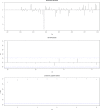Comparison of autoregressive integrated moving average model and generalised regression neural network model for prediction of haemorrhagic fever with renal syndrome in China: a time-series study
- PMID: 31209084
- PMCID: PMC6589045
- DOI: 10.1136/bmjopen-2018-025773
Comparison of autoregressive integrated moving average model and generalised regression neural network model for prediction of haemorrhagic fever with renal syndrome in China: a time-series study
Abstract
Objectives: Haemorrhagic fever with renal syndrome (HFRS) is a serious threat to public health in China, accounting for almost 90% cases reported globally. Infectious disease prediction may help in disease prevention despite some uncontrollable influence factors. This study conducted a comparison between a hybrid model and two single models in forecasting the monthly incidence of HFRS in China.
Design: Time-series study.
Setting: The People's Republic of China.
Methods: Autoregressive integrated moving average (ARIMA) model, generalised regression neural network (GRNN) model and hybrid ARIMA-GRNN model were constructed by R V.3.4.3 software. The monthly reported incidence of HFRS from January 2011 to May 2018 were adopted to evaluate models' performance. Root mean square error (RMSE), mean absolute error (MAE) and mean absolute percentage error (MAPE) were adopted to evaluate these models' effectiveness. Spatial stratified heterogeneity of the time series was tested by month and another GRNN model was built with a new series.
Results: The monthly incidence of HFRS in the past several years showed a slight downtrend and obvious seasonal variation. A total of four plausible ARIMA models were built and ARIMA(2,1,1) (2,1,1)12 model was selected as the optimal model in HFRS fitting. The smooth factors of the basic GRNN model and the hybrid model were 0.027 and 0.043, respectively. The single ARIMA model was the best in fitting part (MAPE=9.1154, MAE=89.0302, RMSE=138.8356) while the hybrid model was the best in prediction (MAPE=17.8335, MAE=152.3013, RMSE=196.4682). GRNN model was revised by building model with new series and the forecasting performance of revised model (MAPE=17.6095, MAE=163.8000, RMSE=169.4751) was better than original GRNN model (MAPE=19.2029, MAE=177.0356, RMSE=202.1684).
Conclusions: The hybrid ARIMA-GRNN model was better than single ARIMA and basic GRNN model in forecasting monthly incidence of HFRS in China. It could be considered as a decision-making tool in HFRS prevention and control.
Keywords: autoregressive integrated moving average; generalized regression neural network; hemorrhagic fever with renal syndrome; prediction.
© Author(s) (or their employer(s)) 2019. Re-use permitted under CC BY-NC. No commercial re-use. See rights and permissions. Published by BMJ.
Conflict of interest statement
Competing interests: None declared.
Figures





Similar articles
-
Comparison of Two Hybrid Models for Forecasting the Incidence of Hemorrhagic Fever with Renal Syndrome in Jiangsu Province, China.PLoS One. 2015 Aug 13;10(8):e0135492. doi: 10.1371/journal.pone.0135492. eCollection 2015. PLoS One. 2015. PMID: 26270814 Free PMC article.
-
Improving the precision of modeling the incidence of hemorrhagic fever with renal syndrome in mainland China with an ensemble machine learning approach.PLoS One. 2021 Mar 16;16(3):e0248597. doi: 10.1371/journal.pone.0248597. eCollection 2021. PLoS One. 2021. PMID: 33725011 Free PMC article.
-
[Application of nonlinear autoregressive neural network in predicting incidence tendency of hemorrhagic fever with renal syndrome].Zhonghua Liu Xing Bing Xue Za Zhi. 2015 Dec;36(12):1394-6. Zhonghua Liu Xing Bing Xue Za Zhi. 2015. PMID: 26850398 Chinese.
-
Application of machine learning in the prediction of COVID-19 daily new cases: A scoping review.Heliyon. 2021 Oct;7(10):e08143. doi: 10.1016/j.heliyon.2021.e08143. Epub 2021 Oct 11. Heliyon. 2021. PMID: 34660935 Free PMC article.
-
A critical review of the use of R2 in risk equalization research.Eur J Health Econ. 2025 Apr;26(3):363-375. doi: 10.1007/s10198-024-01709-8. Epub 2024 Aug 9. Eur J Health Econ. 2025. PMID: 39120657 Free PMC article. Review.
Cited by
-
The roles of machine learning methods in limiting the spread of deadly diseases: A systematic review.Heliyon. 2021 Jun;7(6):e07371. doi: 10.1016/j.heliyon.2021.e07371. Epub 2021 Jun 23. Heliyon. 2021. PMID: 34179541 Free PMC article. Review.
-
Research on the predictive effect of a combined model of ARIMA and neural networks on human brucellosis in Shanxi Province, China: a time series predictive analysis.BMC Infect Dis. 2021 Mar 19;21(1):280. doi: 10.1186/s12879-021-05973-4. BMC Infect Dis. 2021. PMID: 33740904 Free PMC article.
-
ARIMA and ARIMA-ERNN models for prediction of pertussis incidence in mainland China from 2004 to 2021.BMC Public Health. 2022 Jul 29;22(1):1447. doi: 10.1186/s12889-022-13872-9. BMC Public Health. 2022. PMID: 35906580 Free PMC article.
-
Unveiling the future: Wavelet- ARIMAX analysis of climate and diarrhea dynamics in Bangladesh's Urban centers.BMC Public Health. 2025 Jan 24;25(1):318. doi: 10.1186/s12889-024-20920-z. BMC Public Health. 2025. PMID: 39856628 Free PMC article.
-
Forecasting the Tuberculosis Incidence Using a Novel Ensemble Empirical Mode Decomposition-Based Data-Driven Hybrid Model in Tibet, China.Infect Drug Resist. 2021 May 25;14:1941-1955. doi: 10.2147/IDR.S299704. eCollection 2021. Infect Drug Resist. 2021. PMID: 34079304 Free PMC article.
References
Publication types
MeSH terms
LinkOut - more resources
Full Text Sources
Miscellaneous
